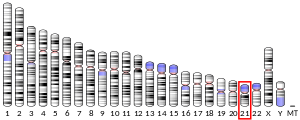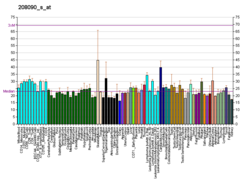自体免疫调节因子
自体免疫调节因子(Autoimmune regulator)是人体内由AIRE基因表现的蛋白质[6]。AIRE是在胸腺髓质表现的转录因子,使人体不会被自身的免疫系统攻击。
每个T细胞都会辨识由抗原呈现细胞上MHC分子复合体呈现的特定抗原,这一识别需要T细胞表面的T细胞受体。T细胞受体由VDJ重组片段所制造,所以T细胞多样性很高,而每个T细胞都有专一性。接著,会辨识自身蛋白质的T细胞受器必须在还在胸腺内时消除。透过AIRE作用,胸腺髓质上皮细胞(mTEC)会表现身体其他各个地方的主要蛋白质(所谓的 TRA),而且将会和这些蛋白质反应的T细胞透过细胞程序性死亡(细胞凋亡)的方式消除。因此AIRE针对自体辨识的T细胞进行负向筛选[7]。当AIRE受损时,会辨识人体自身抗原的T细胞会离开胸腺,进入血液循环,并可能导致许多的自体免疫疾病。
功能
[编辑]在胸腺中,AIRE会促进一个大范围的特定器官基因的转录,并制造出只在周边组织表现的蛋白质,在胸腺中创造“免疫的影子”[8][9]透过负向筛选,将在胸腺中会和自身抗原强烈结合的T细胞消除是很重要的,否则之后他们可能会遇到能强烈结合的自身抗原,引发自体免疫反应。所以在胸腺内借由AIRE表现非当地的蛋白质,消除和自身抗原反应的T细胞,可以降低自体免疫的威胁。再者,AIRE被发现会在次级淋巴组织中一群间质细胞中表现,然而这些细胞表现出的TRAs和mTECs所表现出的不同。[10]。
基因改造鼠相关的研究指出AIRE借由在胸腺内启动多样的自身抗原(例如:胰岛素)的转录而作用[8]。这个表现允许成熟中的胸腺细胞对周边器官展现耐受性,进而抑制自体免疫疾病[9]。
AIRE基因亦会在很多其他组织中表现[11]。AIRE也会在老鼠中的33D1+的树突细胞及人类树突细胞[12]。
病理
[编辑]AIRE基因突变发生于一种罕见的自体免疫疾病,APS-1(Autoimmune Polyendocrinopathy Syndrome type 1),又称作APECED( Autoimmune Polyendocrinopathy-Candidiasis-Ectodermal Dystrophy)。AIRE的阻断会产生许多自体免疫疾病,临床上最常见的案例是甲状旁腺功能减退症、原发性肾上腺皮质功能衰竭和慢性黏膜皮肤念珠菌病[13]。
为了探讨人类的疾病机制,会使用剔除AIRE基因的转基因小鼠模型来进行研究[14]。
相关条目
[编辑]参考资料
[编辑]- ^ 與自體免疫調節因子相關的疾病;在維基數據上查看/編輯參考.
- ^ 2.0 2.1 2.2 GRCh38: Ensembl release 89: ENSG00000160224 - Ensembl, May 2017
- ^ 3.0 3.1 3.2 GRCm38: Ensembl release 89: ENSMUSG00000000731 - Ensembl, May 2017
- ^ Human PubMed Reference:. National Center for Biotechnology Information, U.S. National Library of Medicine.
- ^ Mouse PubMed Reference:. National Center for Biotechnology Information, U.S. National Library of Medicine.
- ^ An autoimmune disease, APECED, caused by mutations in a novel gene featuring two PHD-type zinc-finger domains. Nat. Genet. December 1997, 17 (4): 399–403. PMID 9398840. doi:10.1038/ng1297-399.
- ^ Anderson M, Su M. Aire and T cell development.. Curr. Opin. Immunol. 2011, 23 (2): 198–206. PMC 3073725
 . PMID 21163636. doi:10.1016/j.coi.2010.11.007.
. PMID 21163636. doi:10.1016/j.coi.2010.11.007.
- ^ 8.0 8.1 Anderson MS, Venanzi ES, Klein L, Chen Z, Berzins SP, Turley SJ, von Boehmer H, Bronson R, Dierich A, Benoist C, Mathis D. Projection of an immunological self shadow within the thymus by the aire protein. Science. November 2002, 298 (5597): 1395–401. PMID 12376594. doi:10.1126/science.1075958.
- ^ 9.0 9.1 Liston A, Lesage S, Wilson J, Peltonen L, Goodnow CC. Aire regulates negative selection of organ-specific T cells. Nat. Immunol. April 2003, 4 (4): 350–4. PMID 12612579. doi:10.1038/ni906.
- ^ Gardner J, Devoss J, Friedman R, et al. Deletional tolerance mediated by extrathymic Aire-expressing cells. Science. 2008, 321 (5890): 843–847. PMC 2532844
 . PMID 18687966. doi:10.1126/science.1159407.
. PMID 18687966. doi:10.1126/science.1159407.
- ^ AIRE Gene expression/activity chart. BioGPS - your Gene Portal System. [2009-12-19]. (原始内容存档于2009年12月30日).
- ^ Lindmark E, Chen Y, Georgoudaki AM, Dudziak D, Lindh E, Adams WC, Loré K, Winqvist O, Chambers BJ, Karlsson MC, et al. AIRE expressing marginal zone dendritic cells balances adaptive immunity and T-follicular helper cell recruitment.. Journal of Autoimmunity. 2013, 42: 62–70. PMID 23265639. doi:10.1016/j.jaut.2012.11.004.
- ^ OMIM. [2018-05-21]. (原始内容存档于2009-10-19).
- ^ Ramsey C, Winqvist O, Puhakka L, Halonen M, Moro A, Kämpe O, Eskelin P, Pelto-Huikko M, Peltonen L. Aire deficient mice develop multiple features of APECED phenotype and show altered immune response. Hum. Mol. Genet. 2002, 11 (4): 397–409. PMID 11854172. doi:10.1093/hmg/11.4.397.
延伸阅读
[编辑]- Björses P, Aaltonen J, Horelli-Kuitunen N, et al. Gene defect behind APECED: a new clue to autoimmunity. Hum. Mol. Genet. 1998, 7 (10): 1547–53. PMID 9735375. doi:10.1093/hmg/7.10.1547.
- Heino M, Peterson P, Kudoh J, Shimizu N, Antonarakis SE, Scott HS, Krohn K. APECED mutations in the autoimmune regulator (AIRE) gene. Hum. Mutat. September 2001, 18 (3): 205–11. PMID 11524731. doi:10.1002/humu.1176.
- Sato K, Nakajima K, Imamura H, Deguchi T, Horinouchi S, Yamazaki K, Yamada E, Kanaji Y, Takano K. A novel missense mutation of AIRE gene in a patient with autoimmune polyendocrinopathy, candidiasis and ectodermal dystrophy (APECED), accompanied with progressive muscular atrophy: case report and review of the literature in Japan. Endocr. J. December 2002, 49 (6): 625–33. PMID 12625412. doi:10.1507/endocrj.49.625.
- Ruan QG, She JX. Autoimmune polyglandular syndrome type 1 and the autoimmune regulator. Clin. Lab. Med. March 2004, 24 (1): 305–17. PMID 15157567. doi:10.1016/j.cll.2004.01.008.
- Holmdahl R. Aire-ing self antigen variability and tolerance. Eur. J. Immunol. March 2007, 37 (3): 598–601. PMID 17323409. doi:10.1002/eji.200737152.
- Aaltonen J, Björses P, Sandkuijl L, Perheentupa J, Peltonen L. An autosomal locus causing autoimmune disease: autoimmune polyglandular disease type I assigned to chromosome 21. Nat. Genet. September 1994, 8 (1): 83–7. PMID 7987397. doi:10.1038/ng0994-83.
- Aaltonen J, Horelli-Kuitunen N, Fan JB, Björses P, Perheentupa J, Myers R, Palotie A, Peltonen L. High-resolution physical and transcriptional mapping of the autoimmune polyendocrinopathy-candidiasis-ectodermal dystrophy locus on chromosome 21q22.3 by FISH. Genome Res. August 1997, 7 (8): 820–9. PMID 9267805. doi:10.1101/gr.7.8.820.
- Nagamine K, Peterson P, Scott HS, Kudoh J, Minoshima S, Heino M, Krohn KJ, Lalioti MD, Mullis PE, Antonarakis SE, Kawasaki K, Asakawa S, Ito F, Shimizu N. Positional cloning of the APECED gene. Nat. Genet. December 1997, 17 (4): 393–8. PMID 9398839. doi:10.1038/ng1297-393.
- Scott HS, Heino M, Peterson P, Mittaz L, Lalioti MD, Betterle C, Cohen A, Seri M, Lerone M, Romeo G, Collin P, Salo M, Metcalfe R, Weetman A, Papasavvas MP, Rossier C, Nagamine K, Kudoh J, Shimizu N, Krohn KJ, Antonarakis SE. Common mutations in autoimmune polyendocrinopathy-candidiasis-ectodermal dystrophy patients of different origins. Mol. Endocrinol. August 1998, 12 (8): 1112–9. PMID 9717837. doi:10.1210/me.12.8.1112.
- Heino M, Scott HS, Chen Q, Peterson P, Mäebpää U, Papasavvas MP, Mittaz L, Barras C, Rossier C, Chrousos GP, Stratakis CA, Nagamine K, Kudoh J, Shimizu N, Maclaren N, Antonarakis SE, Krohn K. Mutation analyses of North American APS-1 patients. Hum. Mutat. 1999, 13 (1): 69–74. PMID 9888391. doi:10.1002/(SICI)1098-1004(1999)13:1<69::AID-HUMU8>3.0.CO;2-6.
- Björses P, Pelto-Huikko M, Kaukonen J, Aaltonen J, Peltonen L, Ulmanen I. Localization of the APECED protein in distinct nuclear structures. Hum. Mol. Genet. February 1999, 8 (2): 259–66. PMID 9931333. doi:10.1093/hmg/8.2.259.
- Rinderle C, Christensen HM, Schweiger S, Lehrach H, Yaspo ML. AIRE encodes a nuclear protein co-localizing with cytoskeletal filaments: altered sub-cellular distribution of mutants lacking the PHD zinc fingers. Hum. Mol. Genet. February 1999, 8 (2): 277–90. PMID 9931335. doi:10.1093/hmg/8.2.277.
- Björses P, Halonen M, Palvimo JJ, Kolmer M, Aaltonen J, Ellonen P, Perheentupa J, Ulmanen I, Peltonen L. Mutations in the AIRE gene: effects on subcellular location and transactivation function of the autoimmune polyendocrinopathy-candidiasis-ectodermal dystrophy protein. Am. J. Hum. Genet. February 2000, 66 (2): 378–92. PMC 1288090
 . PMID 10677297. doi:10.1086/302765.
. PMID 10677297. doi:10.1086/302765. - Pitkänen J, Doucas V, Sternsdorf T, Nakajima T, Aratani S, Jensen K, Will H, Vähämurto P, Ollila J, Vihinen M, Scott HS, Antonarakis SE, Kudoh J, Shimizu N, Krohn K, Peterson P. The autoimmune regulator protein has transcriptional transactivating properties and interacts with the common coactivator CREB-binding protein. J. Biol. Chem. June 2000, 275 (22): 16802–9. PMID 10748110. doi:10.1074/jbc.M908944199.
- Pitkänen J, Vähämurto P, Krohn K, Peterson P. Subcellular localization of the autoimmune regulator protein. characterization of nuclear targeting and transcriptional activation domain. J. Biol. Chem. June 2001, 276 (22): 19597–602. PMID 11274163. doi:10.1074/jbc.M008322200.
- Saugier-Veber P, Drouot N, Wolf LM, Kuhn JM, Frébourg T, Lefebvre H. Identification of a novel mutation in the autoimmune regulator (AIRE-1) gene in a French family with autoimmune polyendocrinopathy-candidiasis-ectodermal dystrophy. Eur. J. Endocrinol. April 2001, 144 (4): 347–51. PMID 11275943. doi:10.1530/eje.0.1440347.
外部链接
[编辑]- 医学主题词表(MeSH):AIRE+protein
- Human AIRE genome location and AIRE gene details page in the UCSC Genome Browser.






